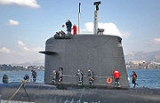
Diving plane
Encyclopedia
A diving plane, also known as a hydroplane, is a control surface
found on submarine
s which allow the vessel to pitch its bow and stern up or down to assist in the process of submerging or surfacing the boat, as well as controlling depth when submerged.
Diving planes function in much the same way as an aircraft's elevator
.
Diving planes are usually fitted in pairs, the bow
planes at the front of the submarine and the stern
planes at the rear.
Diving planes located on the sail (conning tower
) are called fairwater planes on US Navy submarines. Fairwater planes do not pitch the ship up or down, they cause the ship to rise or sink on a level plane as they are operated. Newer ships, starting with the third-flight Los Angeles class
subs (or 688i's) have eliminated the sail planes, and operate instead with bow planes.
Control surface
In the domain of digital audio, a control surface is a human interface device which allows the user to control a digital audio workstation or other digital audio application. Generally, a control surface will contain one or more controls that can be assigned to parameters in the software,...
found on submarine
Submarine
A submarine is a watercraft capable of independent operation below the surface of the water. It differs from a submersible, which has more limited underwater capability...
s which allow the vessel to pitch its bow and stern up or down to assist in the process of submerging or surfacing the boat, as well as controlling depth when submerged.
Diving planes function in much the same way as an aircraft's elevator
Elevator (aircraft)
Elevators are flight control surfaces, usually at the rear of an aircraft, which control the aircraft's orientation by changing the pitch of the aircraft, and so also the angle of attack of the wing. In simplified terms, they make the aircraft nose-up or nose-down...
.
Diving planes are usually fitted in pairs, the bow
Bow (ship)
The bow is a nautical term that refers to the forward part of the hull of a ship or boat, the point that is most forward when the vessel is underway. Both of the adjectives fore and forward mean towards the bow...
planes at the front of the submarine and the stern
Stern
The stern is the rear or aft-most part of a ship or boat, technically defined as the area built up over the sternpost, extending upwards from the counter rail to the taffrail. The stern lies opposite of the bow, the foremost part of a ship. Originally, the term only referred to the aft port section...
planes at the rear.
Diving planes located on the sail (conning tower
Conning tower
A conning tower is a raised platform on a ship or submarine, often armored, from which an officer can con the vessel; i.e., give directions to the helmsman. It is usually located as high on the ship as practical, to give the conning team good visibility....
) are called fairwater planes on US Navy submarines. Fairwater planes do not pitch the ship up or down, they cause the ship to rise or sink on a level plane as they are operated. Newer ships, starting with the third-flight Los Angeles class
Los Angeles class submarine
The Los Angeles class, sometimes called the LA class or the 688 class, is a class of nuclear-powered fast attack submarines that forms the backbone of the United States submarine fleet. With 43 submarines on active duty and 19 retired, the Los Angeles class is the most numerous nuclear powered...
subs (or 688i's) have eliminated the sail planes, and operate instead with bow planes.

